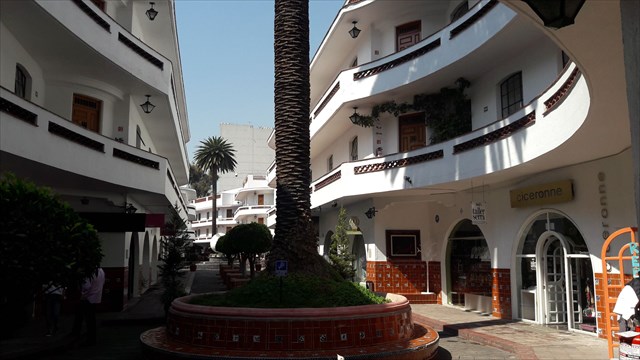Information from / *información de* : http://www.ciudadmexico.com.mx/atractivos/pasaje_polanco.htm
At the heart of one of the most exclusive and dynamic parts of the city, the *Pasaje Polanco* represents a very interesing urban meeting point that combines housing with shopping and it is a classic feature of Mexico City.
The *Pasaje Polanco* was conceived as a urban regeneration project in the Polanco zone at the end of the 1930s. The company "De la Lama y Basurto", which realized much of the urban planning for parts of the city, including Polanco, Colonia del Valle and la Condesa, commissioned the architect Francisco Serrano to design a unique project in the hart of the zone that was going to function as its commercial center.
Covering almost an entire trapezoid-shaped block, the design of the *Pasaje Polanco* was conceived to create an internal street running parallel to Avenida Presidente Masaryk, running between Calle de Julio Verne and Calle Oscar Wilde. The space of this interior street is organized along three little squares which do justice to the undulating geometry of the buildings around it. The focal point of the area is the central plaza which has a wonderful and very special solar clock.
The architecture of the whole thing is characterized by a sobre colonial californian style with white walls, with arcades and balconies. There are discrete sculptured details in differente colours of pink and red. The ground floor of the complex consists of commercial areas, with above it two levels of apartments, with a front gallery that faces the internal street. At street level, the lights and colours of the different shops liven up the sobre freshness of the interior patios. From the outside, the complex has a great relationship with the city: There is extensive interaction through the existence of terraces that connect the inside and the outside. The terraces from Avenida Presidente Masaryk make up some of the liveliest parts of the city. Several restaurants in the area are among the classics of Polanco, such as the famous café Kleinz.
At the interior of the *Pasaje Polanco*, we can encounter various shops with interesting design items and furniture, as well as other creative offices. On a hot spring day, passing through the freshness of the *Pasaje* is an absolute delight.
The *Pasaje Polanco* is open daily from 11am until 8pm, but the cache is located just outside of it, in order to facilitate access.
---------------
*Corazón de una de las zonas más exclusivas y dinámicas de la urbe, Pasaje Polanco, representa además un interesante conjunto urbano que combina viviendas y comercios y que es ya un clásico de la Ciudad de México.*
*Pasaje Polanco fue concebido como parte del proyecto de urbanización de la zona de Polanco a finales de la década de 1930. La compañía “De la Lama y Basurto” empresa que realizó el fraccionamiento de Polanco junto con otras sectores de la ciudad como parte de la Colonia del Valle y la Condesa, comisionó al arquitecto Francisco Serrano para que se encargara de diseñar un proyecto que ocuparía una manzana al centro del fraccionamiento y que debía fungir como el área comercial de la zona.*
*Abarcando casi la totalidad de una manzana trapezoidal, el diseño de Pasaje Polanco concibió crear una calle interna que corre paralela a avenida Presidente Masaryk comunicando la calle de Julio Verne con la de Oscar Wilde. El espacio de esta calle interior está organizado a través de tres plazoletas que dan a pie a la ondulante geometría de los edificios que delimitan el pasaje, siendo el punto focal del conjunto la plaza central con una hermosa fuente que ostenta un notable reloj solar.*
*La arquitectura del conjunto se caracteriza por un sobrio estilo colonial californiano de muros blancos, interrumpidos por arcadas y balcones, detalles discretos esculpidos en cantera rosa y techumbres cubiertas por tejas rojas. Los edificios del conjunto, de planta baja comercial y dos niveles de departamentos, se relacionan con la calle interior a través de corredores que conducen a los accesos de los departamentos. En el nivel de calle, las luces y colores de los escaparates de sus comerciales animan la sobria frescura de los patios interiores. Hacia el exterior, la relación del edificio con la ciudad es óptima: diversos locales comerciales con terrazas y generosas entradas invitan al flujo desde y hacia el edificio. Las terrazas hacia avenida Presidente Masaryk de este conjunto urbano marcan uno de los puntos de mayor vivacidad de toda la avenida y albergan algunos restaurantes clásicos de la zona como la famosa cafetería Kleinz.*
*Al interior de Pasaje Polanco podemos encontrar varias tiendas con interesantes artículos de diseño y mobiliario, así como algunas oficinas creativas. En un día caluroso de primavera, pasearse por la frescura del pasaje resulta todo un deleite.*
*Pasaje Polanco se encuentra abierto diariamente de 11:00 a 20:00 hrs, pero el cache queda justo afuera, para facilitar el acceso*
